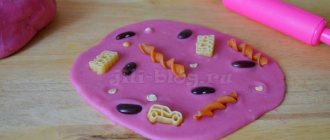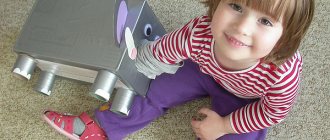What does it mean to develop fine motor skills?
Fine motor skills are the ability to reproduce precise movements with the hand and fingers. This is important not only for developing beautiful handwriting, we must also remember that the phalanges of the fingers are the main tools in the work of representatives of many professions. The development of fine motor skills in children aged 6-7 years is facilitated by drawing, playing musical instruments, working with plasticine and small construction sets. But the greatest effect is obtained as a result of special classes.
The exercises offered to children help develop accuracy and speed of movement. As a result of their implementation, the hands and fingers will become stronger, flexible and mobile. There are three types of such tasks:
- exercises with small objects;
- graphic tasks;
- finger games.
In light of preparing for school, the greatest attention should be paid to completing graphic tasks. Children must learn to hatch and draw lines of different thicknesses and shapes. At the same time, it is necessary to ensure that they draw lines without lifting the pen from the paper, do not go beyond the designated contours, do not leave spaces, perform movements correctly (from top to bottom, left to right), do not turn the notebook, and sit correctly at the table.
Classes to develop fine motor skills of the hands should be carried out regularly, studying for 10 - 20 minutes a day. Monotony and monotony should not be allowed; during the lesson, children should be offered several different exercises with exciting game content. To do this, the teacher and parents are invited to use a card file of exercises for the development of fine motor skills in children 6 - 7 years old.
DIY games for the development of fine motor skills in preschool children aged 2-4 years
Master class for preschool teachers “Do-it-yourself games aimed at developing fine motor skills”
Didactic game “Who eats what”, “Who lives where”.
Didactic manual “Funny nesting dolls”. Didactic manual “Football” For children 2 - 4 years old. This material will be useful to kindergarten teachers, speech therapists, and parents of preschool children. The purpose of the master class: improving the professional skills of teachers, obtaining new knowledge and mastering it in practical activities. “The child has a passion for the game, and it must be satisfied.
We must not only give him time to play, but we must imbue his life with this game. His whole life is a game! A. S. Makarenko. The development of fine motor skills in the hands of preschoolers plays an important role in their overall development, allows for the formation of coordination of finger movements, develops speech, prepares the child for school, and develops creativity and imagination. This is facilitated by games with clothespins, which are very useful for the development of children. By developing the movements of the fingers, we thereby contribute to the development of the child’s intellectual and thinking processes and the development of his speech. In modern stores you can buy any game, but it is games made with your own hands, and even better together with adults, that are most interesting and expensive for a child. Each game is a child’s communication with adults, with other children; This is a school of cooperation in which he learns to both rejoice in the success of his peer and endure his failures. Goodwill, support, a joyful atmosphere of fiction and fantasy - only in this case will games be useful for the development of the child. I bring to your attention a number of simple, but useful and exciting games that can be made from simple materials and do not require large expenditures of both money and time.
Didactic game "Who eats what." "Who lives where"
Goal: development of fine motor skills of the fingers. Objectives: develop cognitive interests, expand and activate vocabulary, develop memory, thinking, attention, logical thinking. Progress of the game Children are asked to attach clothespins with pictures of animals to the circle so that this animal matches the type of food. Having turned the circle over, children are asked to attach clothespins with pictures of animals to the circle so that this animal corresponds to its habitat. During the game, the teacher asks questions: “What is the name of the animal?”, “What does it eat?”, “Where does it live?” etc.. the same animal can eat different foods, this is also clarified during the game. Materials for making the game: a circle of thick cardboard, clothespins, pictures - animal figures, animal habitats, animal food (copied from the Internet or cut out from the lotto (from which cards with pictures were lost), tape. Making the game.
Each side of the circle is divided into 8-12 sectors. On one side of the circle, we glue pictures depicting food for animals into each sector, on the other side of the circle, into each sector we glue pictures depicting the habitat of animals. We glue pictures with images of animals onto clothespins. The game is ready. Now on one side It turned out to be a game “Who eats what”, on the other side of the circle - a game “Who lives where”.
Game guide “Funny nesting dolls”
Goal: development of fine motor skills of the hands. Objectives: to cultivate attention, accuracy, promote the development of self-service skills, develop thinking, the ability to fold fingers in a convenient way when fastening various fasteners. Progress of the game. Children are asked to fasten their nesting dolls. Each nesting doll has its own type of fastener (zipper, hooks of different sizes, lace, buttons of different textures). Materials for making the manual: multi-colored felt, zipper, hooks of different sizes, lace, buttons of different textures (flat, beaded buttons, buttons on the stem), colored threads, a face for nesting dolls (drawn on cardboard and glued with tape). Making a game.
Matryoshka dolls of different sizes are sewn from felt. They are given the shape of a nesting doll. Fasteners of different types are sewn on two sides. The faces are glued on. The guide is ready.
Game manual "Football"
Goal: development of fine motor skills of the hands. Objectives: introduce the game “football”, develop coordination of movements, eye, dexterity, cultivate attention, the ability to cooperate with peers, follow the rules. Progress of the game. Football players wear fingers and pass the ball to each other on the field using their fingers. You can make the game more difficult by placing goals on the field and scoring goals in them. Materials for making the manual: cardboard, felt-tip pens. Making a game.
Figures of football players are cut out of cardboard, and holes for the fingers are cut in place of the legs. The figures are painted.
We recommend watching:
Game technologies in speech therapy work with preschoolers Finger play for preschool children Development of fine motor skills in children 2 - 4 years old with the help of educational games Didactic games for the development of fine motor skills in preschool children
Similar articles:
Development of fine motor skills in children
Game exercises with massage elements for children 5-7 years old to develop fine motor skills
Graphic tasks
Most of these tasks are performed on prepared cards. You can purchase special notebooks, copybooks, and coloring books.
Outlines
The card contains the outlines of objects and a pattern of shading (vertical, horizontal, oblique). The direction of the lines is indicated.
Children need to shade the drawings, trying not to go beyond their contours and make even spaces between the lines.
Rain
The picture shows clouds and flowers below. Children are asked to water the flowers so that they do not wilt. To do this, they need to draw lines. This task can be performed several times, each time offering a picture with different types of lines.
Waves
You need to circle the boat and draw waves on the water. Please note that the lines are of different types (straight and curved).
Fish
You should complete the lines of the fins and scales.
Patterned shading
The card contains examples of curly lines. Children must place a pencil on a dot and draw a line to complete the patterns. The main thing is to try not to lift the pen from the paper until the line is completed.
Complete the drawing
Children will enjoy completing tasks to complete the pictures:
- complete the cage for the tiger cub;
- complete the pyramid, shade every second ring;
- complete the butterfly, etc.
Connect the dots
It is necessary not only to draw lines in the desired direction, but to draw the grass near the house by connecting the dots in pairs. In a more complex version, it is proposed to connect all the points with one line.
Develop your eye
In such tasks, you need to try to draw lines between objects yourself. At first, children are given easier tasks when they need to draw arched curved lines. It is much more difficult for children to draw straight lines so that they hit the target as accurately as possible.
- help the bunny jump over the bumps;
- hit the ball in the basket;
- help restore the volleyball net;
- hit the target in the shooting range.
- Draw with pressure
- In this task you need to perform shading using the correct pressure:
- shade the clouds so that one is darker and the other is lighter;
- shade the glasses - one with water (it’s almost transparent), the other with juice (much darker);
- Shade the leaves, making them different in color intensity.
Repeating the pattern by cells
For such a task, cards lined in a cage are prepared. At the beginning of the line, the “rhythm” of the pattern is set, which you need to repeat independently until the end of the line.
Graphic dictations
You can invite children to perform graphic dictations on checkered cards. In such tasks, the number of cells and the direction of movement of the line are indicated. If the dictation is completed correctly, an image of some object appears on the card. Read more about How to conduct graphic dictations in kindergarten.
Games with objects
Usually young children are protected from playing with small objects. After all, they can put them in their mouth or put them in their ear. However, after 5 years such classes are simply necessary.
Games with sand and granular substances
Children can be given the following tasks:
- pour sand from one container to another;
- pour sand with a measuring spoon;
- sift sand through a sieve;
- finger painting in the sand;
- modeling from wet sand;
- searching for buried small objects in the sand.
The most exciting activity in this series is creating crafts from colored salt.
Games with cereals and seeds
Cereals have a coarser texture than sand. Therefore, they can be used for sorting. To do this, take a handful of cereals or seeds of three different types and pour them into one pile. The child is given three small containers into which he must place the grains. This can be done with your fingers or use tweezers.
In another game, children are asked to determine which grains are by touch. To do this, they are scattered into small fabric bags that are tied tightly. You need to take the bag and, having crushed it in your hands, name the cereal.
You can make pictures from cereals and seeds and create applications on plasticine.
Games with buttons
The buttons are larger. They are also suitable for sorting (by size, shape, color). In addition, buttons can be used to lay out ornaments, paths, lines according to a given pattern, pictures.
take on vector
A very interesting task is to fill in the circles in the picture with buttons, matching them by color.
Games with ropes
Games with ropes and laces are great for developing fine motor skills in children. They can be used for tying and untying knots, braiding or macrame.
The task associated with stringing beads is very useful. It’s better to make these “beads” yourself by cutting cocktail tubes. You can specify the exact number of beads that need to be strung or ask to create a beautiful pattern from them, alternating them by color.
Many games involve lacing. Such tasks can often be found on the pages of educational books made from felt.
Games with paper
When working with paper, offer children the following tasks:
- crumpling and smoothing a sheet of paper;
- folding origami.
A very fun game of creating a planned mess. First, children are asked to tear colored paper into small pieces, and then make colorful rain out of them by throwing them into the air. After the active phase of the game, you need to ask the kids to help collect all the scraps, which is also very useful for the development of fine motor skills. These pieces can be used for torn applique. During this game, invite children to tear paper of different thicknesses (from newspapers to cardboard).
Games with clothespins
The set should contain clothespins of different colors. Also, for such games you need to prepare different templates. You can offer the following tasks:
- attach needles to the hedgehog;
- add rays to the sun;
- do a boy's hair.
Games with clothespins are very popular in math and reading classes, so you can combine these types of activities and ask children to use clothespins to:
- count examples;
- attach the appropriate number of clothespins to the number template;
- indicate the required letter.
Games with matches
Although matches are not a toy for children, they can be used for activities to develop fine motor skills by giving the following tasks:
- moving from stack to stack;
- laying out the figures drawn in the picture from matches;
- folding into a box.
Children love to assemble matches into a cube with a small hole in the center of one of the faces. You can use cotton swabs instead of matches.
Development of fine motor skills in children
Many parents know about the importance of developing fine motor skills in children.
Indeed, this is a very important aspect in the development of a child. The development of speech, coordination skills, dexterity, and intelligence depend precisely on how well the fine motor skills of the fingers are developed. The fact is that the brain centers responsible for speech and finger movement are located close and as one develops, the other also develops.
How to develop fine motor skills in children, what games and exercises are there? I have prepared a sample list for you. Try it with your baby and see how he copes with it. Not everything can be achieved at once; for some games and tasks it is necessary to develop a skill. During the exercises, dexterity and precision of movements are trained. If at 5-6 years old tasks are difficult to complete and the child avoids such games and tasks, then I recommend coming for a consultation with a speech therapist so that children do not have problems with writing at school. The inability to perform precise movements in children of this age may indicate disorders that require diagnosis and correction.
From 1 year to 3 years
- massage of fingers, palms and self-massage, including a needle ball (su-jok), massage of the hands with a hair brush;
- massage the fingertips with a clothespin + attach clothespins to a rope, onto a sheet of paper;
- draw with your fingers in the sand;
- massage in cereals with sea salt (pour the cereal and salt into a container) + remove small objects from the cereal and try to identify the object by touch;
- sort through cereals (peas, beans, buckwheat, rice); place the cereal into different jars with both hands;
- finger games (goat-cow, rings, chains, fan, house, palms, etc.) and shadow theater;
- turning the pages of a book;
- finger small beads;
- collect small objects one by one in a handful;
- screw in, tighten caps, nuts;
- build towers from cubes, collect pyramids.
From 3 years to 4-5 years
- modeling from plasticine;
- stretch the rubber band with the fingers of one hand;
- drawing with stencils;
- collect large and small mosaics and puzzles;
- string beads onto a string (thread);
- games with construction sets (Lego, etc.), assembling construction sets according to diagrams;
- tear paper into small pieces;
- roll plasticine balls with one hand;
- snapping fingers;
- fasten, unfasten buttons;
- tie, untie knots (you can “weave” beads and buttons into the knots).
From 4-5 years
- drawing on dots, dotted lines;
- assembling construction sets with small parts (Lego, metal construction sets);
- shading, carefully coloring figures with colored pencils;
- lace shoes, including according to patterns;
- lay out figures, letters, numbers, a well of matches, small sticks;
- cut out shapes from paper, cut along the marked lines;
- applique;
- draw with chalk (on a blackboard, asphalt), walk paths with paints along given “routes”,
- decorate with paints;
- embroidery on canvas;
- sewing on buttons;
- roll the pencil between the fingers of one hand;
- origami according to schemes.







